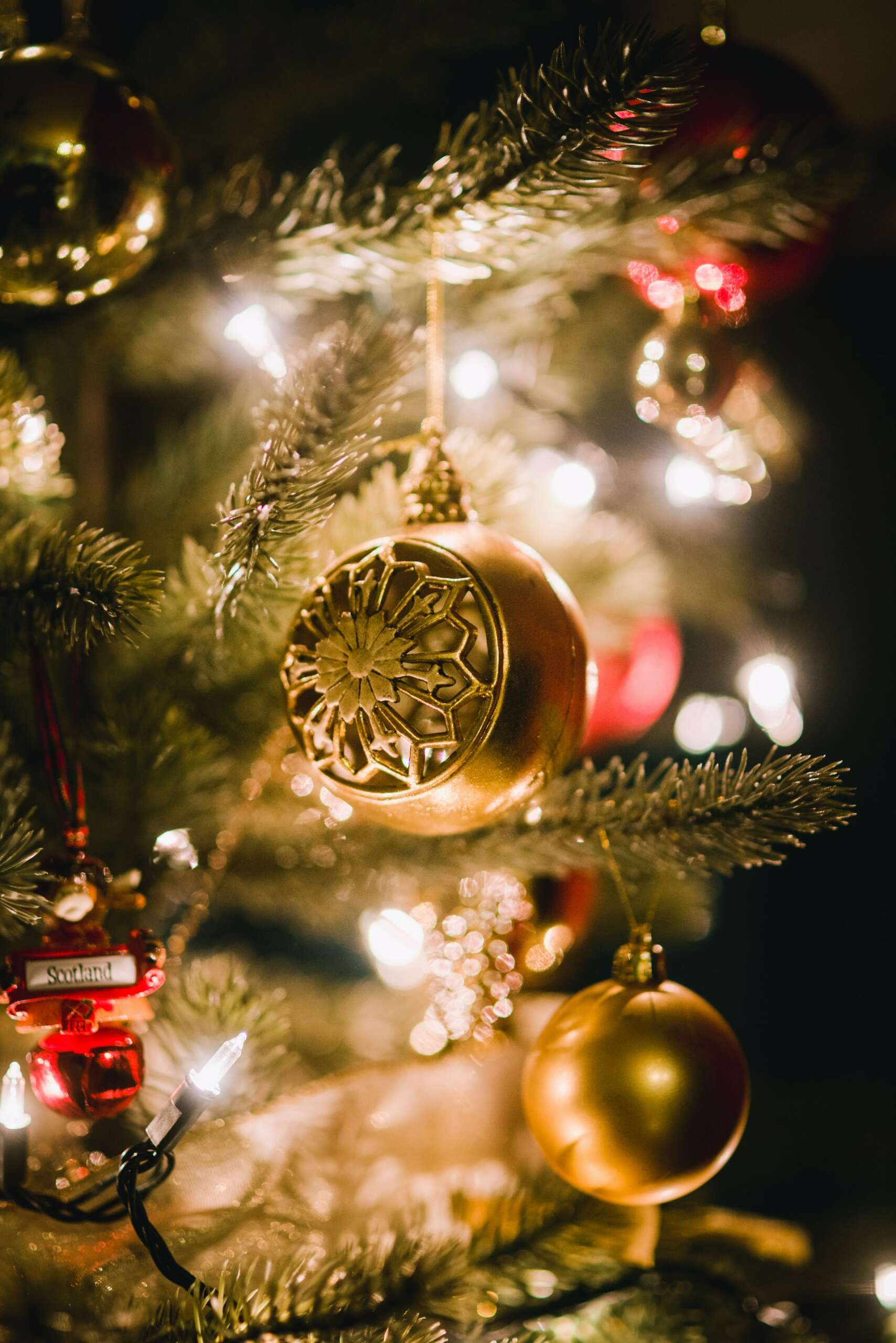Welcome to a colorful journey into the rich history of the Day of the Dead! This centuries-old celebration, also known as Día de los Muertos, is a vibrant and cherished tradition that pays homage to the cycle of life and death. Originating from indigenous Aztec rituals and influenced by Spanish Catholicism, this unique celebration has captivated people from all walks of life.
Join us as we delve into the origins, symbols, and traditions of the Day of the Dead. Discover how this celebration has evolved over time, its impact on art and media, and its growing popularity around the world. From its significance as a celebration of life to its cultural importance in preserving identity and heritage, the Day of the Dead holds a special place in the hearts of those who partake in this annual commemoration.
Key Takeaways:
- The Day of the Dead is a vibrant and colorful celebration that honors the cycle of life and death.
- It originated from indigenous Aztec rituals and was influenced by Spanish Catholicism.
- The celebration takes place over two days, beginning on November 1st.
- It is an opportunity for people to remember and honor their loved ones who have passed away.
- The Day of the Dead has gained popularity in the United States and around the world.
The Origins of Day of the Dead
The Day of the Dead, also known as Día de los Muertos, has a rich historical background rooted in ancient Mesoamerican civilizations. This vibrant celebration of life and death can be traced back to the indigenous peoples of Mexico, such as the Aztecs and Maya. These cultures believed that death was not the end, but rather a natural part of the life cycle.
The ancient civilizations held elaborate burial ceremonies and built shrines to honor their deceased loved ones. When the Spanish arrived in the 16th century, they introduced All Saints’ Day and All Souls’ Day to the region, which coincided with the existing traditions. Over time, the customs blended together to form the Day of the Dead as it is known today.
This unique celebration is a testament to the resilience of indigenous cultures and their ability to adapt and preserve their traditions. It serves as a powerful reminder of the ancient roots of the Day of the Dead and the enduring importance of honoring one’s ancestors.
Ancient Rituals and Modern Celebrations
The ancient rituals of the Aztecs and Maya form the foundation of the modern Day of the Dead celebrations. These ancient cultures believed in the existence of an afterlife and viewed death as a continuation of the journey, rather than an end. They celebrated death with colorful festivities, feasts, and offerings to the deceased.
Today, the Day of the Dead is celebrated with similar joy and vibrancy. Families create ofrendas, or altars, adorned with photographs, candles, marigolds, and the favorite foods and drinks of their departed loved ones. The streets come alive with parades, music, and dancing, as people dressed in elaborate costumes and skeletal makeup pay homage to the spirits.
While the Day of the Dead has evolved over time and has been influenced by various cultures, its ancient roots remain deeply embedded in the traditions and customs followed today. It is a celebration that honors the past, embraces the present, and looks forward to the future.
Symbols and Traditions of Day of the Dead
The Day of the Dead is a richly symbolic celebration that encompasses various traditions and customs. These symbols and traditions play a significant role in honoring and remembering loved ones who have passed away.
Altars or Ofrendas
One prominent tradition during the Day of the Dead is the construction of altars, known as ofrendas, in homes and cemeteries. These altars are beautifully decorated with photographs, mementos, and personal items that belonged to the deceased. They also feature vibrant marigold flowers, candles, and sugar skulls, creating an inviting space for the spirits to visit.
Skeletons and Skulls
The use of skeletons and skulls, known as calacas and calaveras, is a distinctive feature of the Day of the Dead celebrations. These symbols represent the idea that death is a natural part of life and should be embraced rather than feared. They are often depicted in colorful and joyful ways, with intricate designs and patterns.
Grave Visits and Offerings
During the Day of the Dead, families visit the graves of their loved ones to clean and decorate them with flowers, candles, and other offerings. It is believed that these offerings, such as food and drink, provide nourishment and comfort to the spirits. This act of remembrance allows families to connect with their ancestors and continue their bonds beyond death.
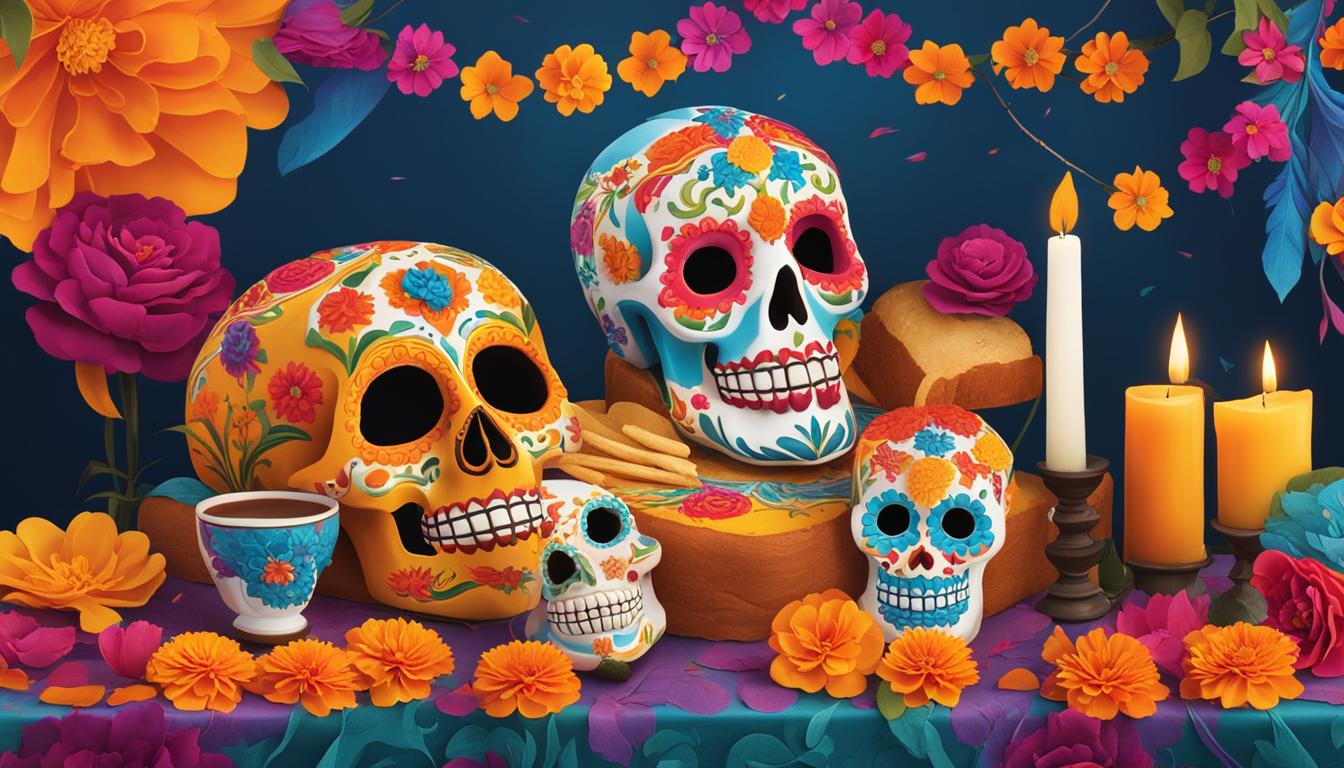
| Symbol | Meaning |
|---|---|
| Marigold Flowers | Represent the fragility and beauty of life. |
| Sugar Skulls | Symbolize the souls of the departed and are often inscribed with the names of loved ones. |
| Candles | Guide the spirits back to their families and provide light on their journey. |
| Food and Drink | Offerings to nourish and provide sustenance to the visiting spirits. |
“The Day of the Dead is an opportunity to celebrate the lives of our departed loved ones and keep their memory alive.”
These symbols and traditions of the Day of the Dead are deeply rooted in Mexican culture and hold great significance in honoring the cycle of life and death. They provide a meaningful and heartfelt way to remember and celebrate the lives of those who have passed away, while also embracing the beauty and resilience of life itself.
The Significance of Día de los Muertos
The celebration of Día de los Muertos holds great cultural and emotional significance to those who observe it. This vibrant Mexican tradition offers a unique opportunity to remember and honor loved ones who have passed away. It serves as a powerful reminder of the connection between life and death, and the importance of embracing both.
One of the key aspects of Día de los Muertos is the building of altars, or ofrendas, to honor the deceased. These altars are adorned with photographs, mementos, and the favorite foods and drinks of the departed. The act of constructing these altars allows families to create a physical space where they can remember and celebrate the lives of their loved ones.
“Día de los Muertos is a time for reflection, remembrance, and celebration. It’s a beautiful way to honor our ancestors and keep their memory alive,” says Maria Hernandez, a participant in the annual celebration.
The significance of Día de los Muertos extends beyond individual families. It is a collective celebration that brings communities together to honor and remember their shared history. The vibrant colors, festive music, and intricate artwork associated with the holiday create a joyful atmosphere that celebrates life and the resilience of the human spirit.
Table: Symbols and Meanings of Día de los Muertos
| Symbol | Meaning |
|---|---|
| Marigolds (cempasúchil) | Symbolize the fragility and beauty of life. Their vibrant color and scent are thought to guide the spirits of the deceased back to their loved ones. |
| Papel picado | Intricate paper cutouts that represent the fragility of life. They are hung as decorations and create a vibrant and festive atmosphere. |
| Sugar skulls (calaveras de azúcar) | Colorful and intricately decorated sugar skulls are a symbol of the cycle of life and death. They are often personalized with the names of departed loved ones. |
| Pan de Muerto | A sweet bread shaped like bones and topped with sugar. It is traditionally offered to the spirits of the departed and shared among the living. |
Through the rituals and traditions of Día de los Muertos, participants not only honor their loved ones but also come to terms with their own mortality. The celebration serves as a reminder to cherish the precious moments of life and to embrace the inevitability of death as a natural part of the human experience.
As Maria Hernandez poignantly states, “Día de los Muertos is a celebration that reminds us that death is not an end, but a continuation of life in a different form.”
The Popularity of Day of the Dead in the United States
The Day of the Dead celebrations have gained significant popularity in the United States in recent years. While it was not widely celebrated by those born and raised in the US a few decades ago, there has been a resurgence of interest in the holiday, especially among those who want to reconnect with their indigenous heritage.
The recognition of the Day of the Dead by UNESCO in 2008 and the release of the Disney Pixar film “Coco” in 2017 have played a significant role in increasing its popularity. The UNESCO recognition helped bring attention to the cultural importance of the holiday, while the film “Coco” introduced the traditions and symbolism of the Day of the Dead to a global audience, making it more accessible and widely known.
Today, the Day of the Dead is celebrated in many cities across the United States, with vibrant parades, art exhibitions, and cultural events that showcase the rich traditions and customs associated with the holiday. People of all backgrounds are drawn to the beauty, symbolism, and community spirit of the Day of the Dead, making it not only a Mexican tradition but a part of the cultural fabric of the United States as well.
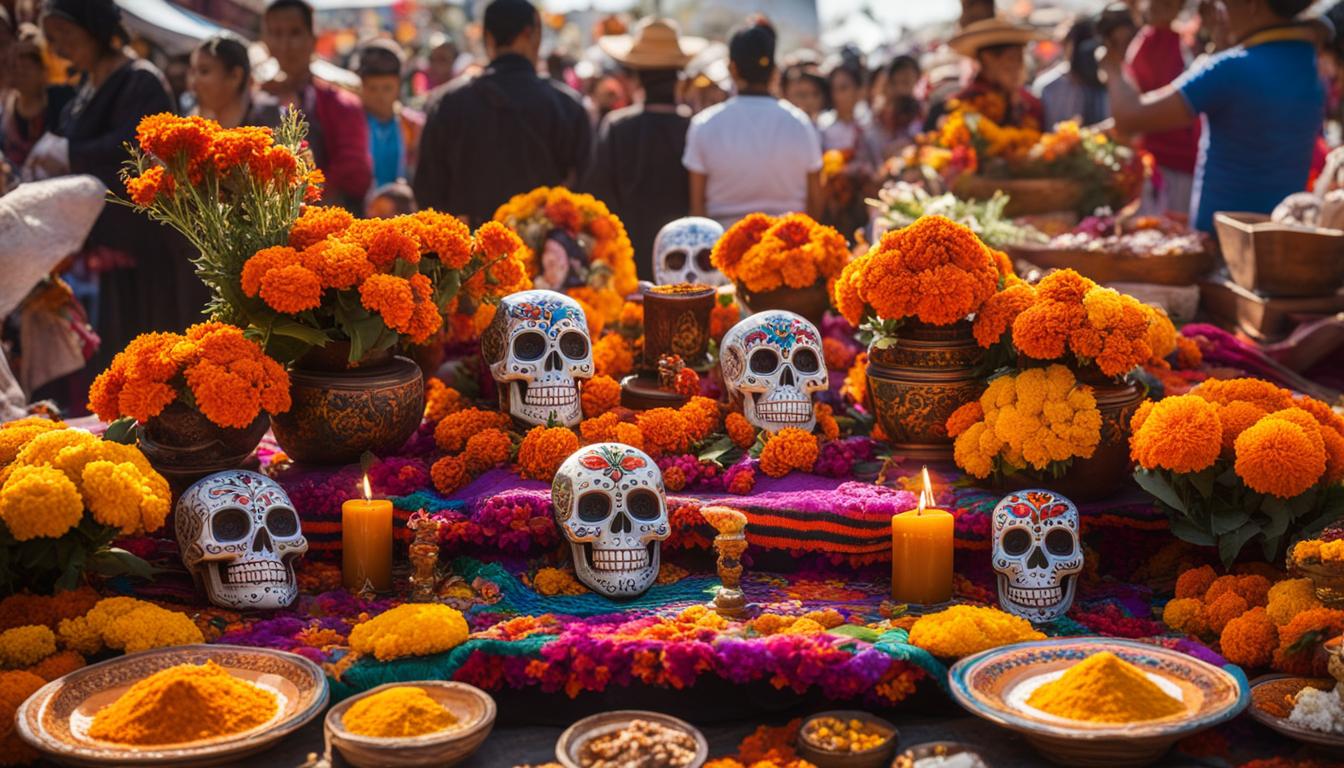
The Influence of Day of the Dead in American Culture
The growing popularity of the Day of the Dead in the United States reflects a broader cultural shift towards embracing diversity and appreciating different traditions. As more people learn about the history and significance of the holiday, they are drawn to its message of honoring and remembering loved ones who have passed away.
The Day of the Dead has also had a significant impact on various aspects of American culture, including art, fashion, and culinary trends. The vibrant colors, intricate designs, and distinctive imagery associated with the holiday have been incorporated into paintings, clothing, and home decor. Traditional Mexican dishes, such as pan de muerto and sugar skulls, have also become popular treats during the holiday season.
Overall, the increasing popularity of the Day of the Dead in the United States signifies a celebration of cultural diversity and a willingness to embrace and learn from different traditions. It is a testament to the power of shared experiences and the universal human desire to remember and honor those who have come before us.
| Year | Event | Impact |
|---|---|---|
| 2008 | UNESCO recognition | Raises awareness of the cultural importance of the holiday |
| 2017 | Release of the film “Coco” | Introduces Day of the Dead traditions to a global audience |
| Present | Day of the Dead celebrations in the US | Inspires vibrant parades, art exhibitions, and cultural events |
Day of the Dead Around the World
Although the Day of the Dead is most strongly associated with Mexico, similar celebrations honoring the deceased exist in other cultures around the world. In countries such as Bolivia, Brazil, and Spain, similar traditions take place during the same time of year. Each culture brings its unique customs and rituals to honor and remember their loved ones.
In Bolivia, the celebration of the Day of the Dead, known as Ñatitas, is a fusion of indigenous beliefs and Catholic traditions. Families gather in cemeteries to pay homage to the skulls of their ancestors, which they believe possess protective and healing powers. The skulls are adorned with flowers, candles, and cigarettes as offerings.
In Brazil, the Day of the Dead is known as Dia de Finados and is celebrated on November 2nd. Families visit cemeteries to pray for and remember their loved ones. They clean and decorate the graves with flowers and light candles to bring comfort to the souls of the departed.
In Spain, the Day of the Dead is celebrated in various regions, such as Catalonia and Andalusia, with traditions similar to those in Mexico. Families build altars in their homes or visit cemeteries to honor the deceased. Offerings of food, drink, and flowers are made, and candles are lit to guide the spirits back to the world of the living for a joyful reunion.
These diverse celebrations demonstrate the universal human need to honor and remember loved ones who have passed away. While the Day of the Dead may have its roots in Mexico, its message of love, remembrance, and celebration of life resonates with people around the world.
The Impact of Day of the Dead on Art and Media
The Day of the Dead has had a profound impact on art and media, inspiring artists and filmmakers around the world. The iconic imagery of skeletons and skulls, known as calacas and calaveras, has become synonymous with the celebration, representing the cycle of life and death. These vibrant and colorful symbols have been incorporated into various forms of artistic expression, including paintings, sculptures, and literature. Artists use their creativity to capture the essence of the Day of the Dead, infusing their work with the joy and beauty that surround this cultural tradition.
One notable example of the Day of the Dead’s influence on media is the release of the film “Coco” in 2017. This animated feature by Disney Pixar brought the celebration to a global audience and received critical acclaim for its authentic representation of Mexican culture and traditions. “Coco” tells the heartwarming story of a young boy named Miguel who embarks on a journey through the Land of the Dead to uncover his family’s hidden past. The film beautifully captures the spirit of the Day of the Dead, showcasing its significance as a time to remember and honor loved ones.
“The vibrant colors, intricate details, and meaningful symbolism of the Day of the Dead have captivated audiences worldwide. It is a visual feast for the eyes and a celebration of life that transcends cultural boundaries.” – Art Critic
In addition to film, the Day of the Dead has influenced the world of literature. Many authors have drawn inspiration from this rich cultural tradition, incorporating its themes and symbolism into their works. These literary creations help to further propagate the significance of the celebration and offer a deeper understanding of its historical and cultural contexts.
The Impact of Day of the Dead on Contemporary Art
Contemporary artists continue to be inspired by the Day of the Dead, pushing the boundaries of traditional art forms and exploring new mediums. The celebration’s vibrant colors, intricate patterns, and themes of life and death serve as a wellspring of inspiration. Artists often use their work to comment on social and political issues, combining the aesthetics of the Day of the Dead with contemporary perspectives to create thought-provoking pieces.
Overall, the Day of the Dead has left an indelible mark on the world of art and media. Its symbolism and cultural significance continue to inspire artists, filmmakers, and writers, ensuring that this vibrant celebration remains a source of creative inspiration for generations to come.
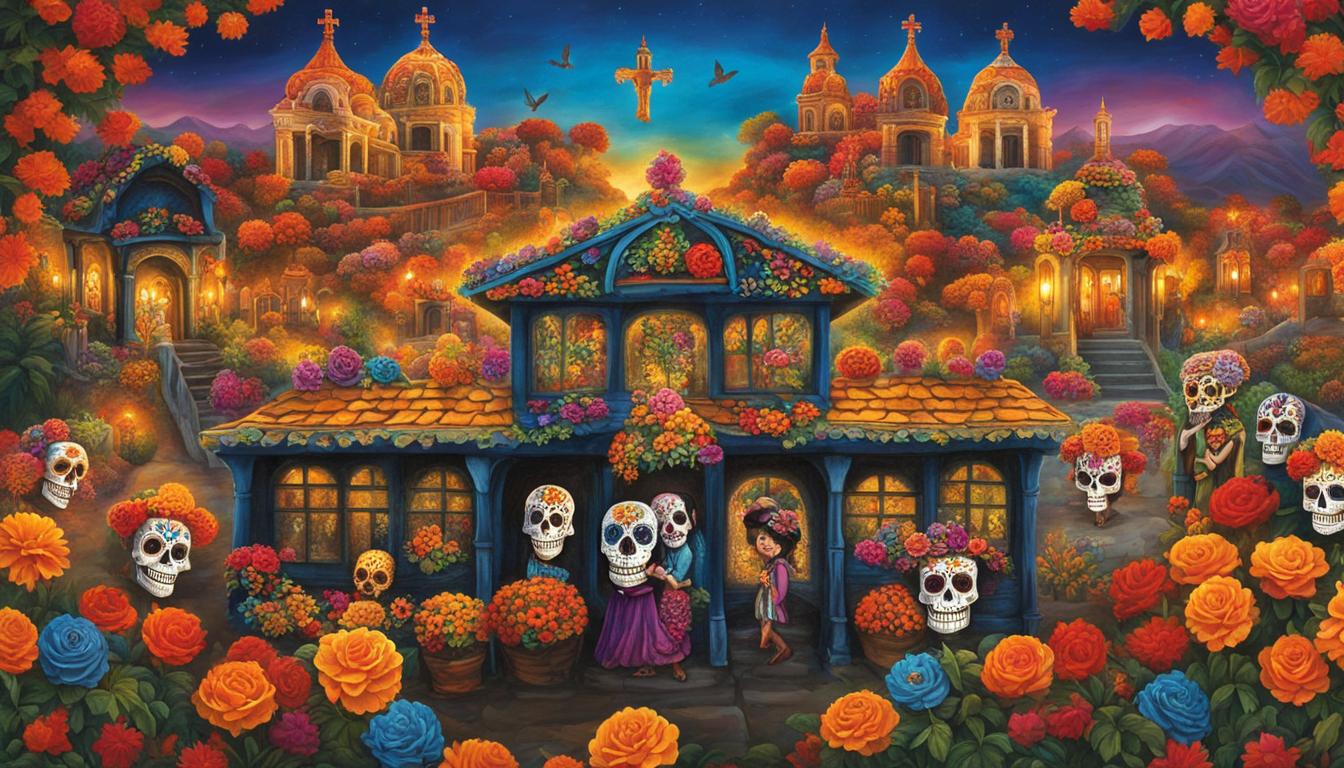
The Symbolism of Day of the Dead
| Symbol | Meaning |
|---|---|
| Calacas and Calaveras | Depicting skeletons and skulls in a lively and cheerful manner, representing the joyous cycle of life and death. |
| Marigold Flowers | Believed to guide the spirits back to the living world with their vibrant colors and scent. |
| Pan de Muerto | A sweet bread shaped like a skull or crossbones, symbolizing the circle of life and the Eucharist. |
| Candles | Used to light the way for the spirits, providing warmth and illumination on their journey. |
| Altars (Ofrendas) | Constructed to honor the deceased, adorned with photographs, mementos, and favorite foods. |
The Day of the Dead is a celebration that embraces the beauty of life and the inevitability of death. It is a time for families to come together, remember their loved ones, and celebrate their presence in their lives. The festive atmosphere, vibrant colors, and joyful traditions make the Day of the Dead a truly unique and cherished celebration.
The Cultural Significance of Day of the Dead
The Day of the Dead holds immense cultural significance, particularly in Mexican culture. It serves as a powerful way for individuals to connect with their ancestral roots, preserve indigenous traditions, and strengthen community bonds. This vibrant celebration promotes the idea that death is not something to be feared but rather embraced as an integral part of life.
The Day of the Dead is deeply ingrained in the fabric of Mexican society. It provides a tangible link to the past, allowing people to honor and remember their ancestors through various customs and rituals. The festivities include building altars adorned with photographs, mementos, flowers, and food, creating a space for the spirits of the departed to be welcomed back into the world of the living.
Furthermore, the Day of the Dead reinforces the notion of communal support and solidarity. Families and communities come together during this time to share stories, memories, and favorite foods of their loved ones who have passed away. It is a time for reflection, healing, and finding comfort in the presence and guidance of ancestral spirits.
The Role of Day of the Dead in Cultural Identity
The Day of the Dead plays a crucial role in shaping and preserving cultural identity and heritage. It serves as a powerful reminder of the rich cultural diversity of Mexican people, as well as their resilience in the face of historical and contemporary challenges. This celebration fosters a sense of belonging and pride in ancestral traditions, reinforcing the importance of cultural heritage for future generations.
| Key Points | Quote |
|---|---|
| The Day of the Dead strengthens community bonds. | “During this time, our community comes together to support one another and honor those who have passed away. It’s a beautiful reminder of the importance of our shared experiences and the strength we find in unity.” |
| Day of the Dead celebrations connect individuals with their ancestral roots. | “As I build the altar for my grandparents, I feel a deep connection to my heritage and a sense of belonging. It’s a way for me to honor their memory and keep our family traditions alive.” |
| Day of the Dead highlights the resilience of indigenous culture. | “Our indigenous ancestors were able to preserve their traditions despite colonization and adversity. The Day of the Dead is a testament to their strength and the enduring legacy they have left behind.” |
The Day of the Dead is not only a celebration of life but also a powerful tool for cultural preservation. It reinforces the idea that our history, traditions, and ancestral connections are vital components of our identity. As a living tradition, it will continue to evolve, adapt, and inspire future generations, ensuring that the cultural significance of this vibrant celebration endures.
Day of the Dead and Family Traditions
The Day of the Dead is a deeply personal and family-oriented tradition. Families come together to honor their deceased loved ones, sharing stories, memories, and favorite foods. It is a time for reflection, healing, and finding comfort in the presence and guidance of ancestral spirits.
During this celebration, families create ofrendas, or altars, to honor their departed loved ones. These altars are adorned with photographs, candles, marigolds, and the deceased’s favorite food and beverages. It is believed that the spirits of the departed return to visit their families during this time, and the ofrendas serve as a welcoming space for them.
In addition to the ofrendas, families also visit the graves of their loved ones, cleaning and decorating them with flowers and candles. It is a time to pay respects and offer prayers for the deceased. Some families may even spend the entire night at the graveyard, sharing stories and memories of their loved ones.
The Day of the Dead is not only a time to remember the departed but also a time to strengthen family bonds. Families come together to support one another in their grief and find solace in the shared experience of celebrating the lives of their loved ones. This tradition reinforces the importance of family and the intergenerational connections that exist within it.
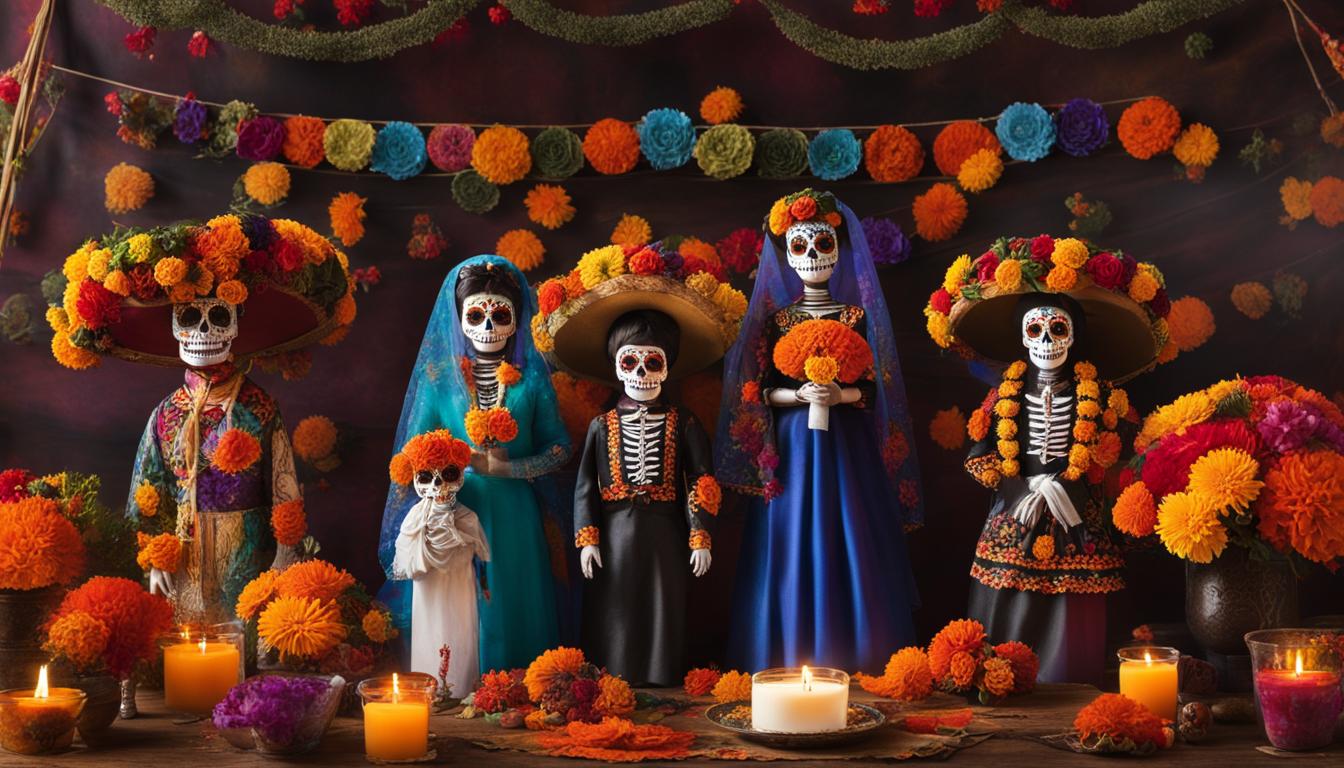
Table: Traditional Foods for Day of the Dead
| Food | Description |
|---|---|
| Pan de Muerto | A sweet bread decorated with bone-shaped pieces symbolizing the bones of the departed. |
| Calaveras de Azucar | Sugar skulls intricately decorated with colorful icing and the names of the deceased. |
| Mole | A rich and flavorful sauce made with chocolate, chili peppers, and various spices served over meat. |
| Tamales | Corn dough filled with delicious fillings such as meat, cheese, or vegetables, wrapped in corn husks, and steamed. |
| Atole | A warm and comforting drink made with corn masa, flavored with cinnamon, vanilla, or chocolate. |
“The Day of the Dead is a time to come together as a family, to remember and honor our loved ones who have passed away. It is a celebration of their lives and a reminder that they are always with us in spirit.”
“Through the rituals and traditions of the Day of the Dead, we find solace and comfort in the presence of our ancestors. We gather as a family, sharing stories, food, and prayers, creating a bond that transcends time and death.”
As the Day of the Dead approaches, families across Mexico and beyond prepare to celebrate this rich and meaningful tradition. It is a time to remember, honor, and connect with loved ones, creating a sense of continuity and belonging that bridges the gap between the living and the deceased. The Day of the Dead is a testament to the enduring power of family, love, and remembrance.
Day of the Dead in Modern Times
In modern times, the Day of the Dead has transcended its traditional roots and has become a global phenomenon. People from different cultures and backgrounds have embraced and participated in the celebration, appreciating its beauty, symbolism, and the opportunity to remember and honor their own departed loved ones.
The recognition of the Day of the Dead by UNESCO in 2008 and the release of the Disney Pixar film “Coco” in 2017 have played a significant role in increasing its popularity. The UNESCO designation affirmed the cultural significance of the celebration, while “Coco” provided a visually stunning portrayal of the traditions and meaning behind the Day of the Dead, captivating audiences worldwide.
“Coco” has been particularly influential in introducing the Day of the Dead to a global audience. The film beautifully portrays the importance of family, the power of memory, and the celebration of life and death. It has sparked curiosity and interest in the cultural aspects of the Day of the Dead, encouraging people from all walks of life to learn more about this vibrant tradition.
With the advent of social media, the Day of the Dead has gained even more visibility and reach. People share their personal experiences, photographs of their ofrendas, and stories of their loved ones online, connecting with others who are also celebrating and keeping the tradition alive. This virtual community has not only helped to preserve the essence of the Day of the Dead but has also allowed it to evolve and adapt in new and innovative ways.
As the Day of the Dead continues to transcend borders and gain popularity, its core values of remembrance, celebration, and the recognition of the cycle of life and death remain at the heart of the tradition. It serves as a powerful reminder of the universal human experience of loss and the importance of honoring and cherishing the memories of those who have passed away.
The Future and Continuation of Day of the Dead
The Day of the Dead is a living tradition that continues to evolve and adapt with the changing times. It is likely to endure for generations to come, providing future generations with a powerful connection to their roots and a meaningful way to remember and celebrate their ancestors.
The celebration of the Day of the Dead holds immense cultural significance and plays a vital role in shaping and preserving cultural identity and heritage. It serves as a reminder of the rich and diverse history of the Mexican people, reinforcing a sense of belonging and fostering pride in ancestral traditions.
As the world becomes more interconnected, the Day of the Dead has transcended its traditional boundaries and has gained recognition and appreciation across different cultures and backgrounds. This global phenomenon allows people from all walks of life to participate in and experience the beauty and symbolism of the celebration, while also providing them with an opportunity to remember and honor their own departed loved ones.
The future of the Day of the Dead is bright and promising. It will continue to be a dynamic and vibrant expression of love, remembrance, and cultural heritage. As society evolves, so too will the ways in which people celebrate, incorporating new customs and practices while preserving the core traditions that make the Day of the Dead so unique and meaningful.
| Key Points | Future Outlook |
|---|---|
| The Day of the Dead is a living tradition | It will endure for generations to come |
| Preserves cultural identity and heritage | Shapes and reinforces a sense of belonging |
| Has gained global recognition | Allows people from diverse backgrounds to participate |
| Continues to evolve and adapt | Incorporates new customs while preserving core traditions |
The Impact of Day of the Dead on Identity and Cultural Heritage
The Day of the Dead holds immense significance in shaping and preserving cultural identity and heritage. It serves as a powerful reminder of the rich traditions and cultural diversity of the Mexican people. This vibrant celebration reinforces a sense of belonging and fosters pride in ancestral customs, contributing to the preservation of indigenous culture amidst historical and contemporary challenges.
The Day of the Dead is deeply ingrained in Mexican society, fostering a strong connection to ancestral roots. It provides a platform for individuals to honor their deceased loved ones and reflect on their own cultural heritage. Through the celebration’s colorful traditions and symbolic rituals, the Day of the Dead creates a collective experience that strengthens community bonds and reinforces a shared identity.
Furthermore, the Day of the Dead has had a significant impact on various forms of artistic expression and media. The iconic imagery of skeletons and skulls has become synonymous with this celebration, inspiring artists and capturing the imagination of people worldwide. From paintings to sculptures, literature to films, the Day of the Dead has become a source of inspiration that showcases the resilience and beauty of indigenous culture.
Table: The Impact of Day of the Dead on Identity and Cultural Heritage
| Impacts | Description |
|---|---|
| Preservation of Cultural Identity | The Day of the Dead reinforces a sense of belonging and fosters pride in ancestral traditions, preserving Mexican cultural identity. |
| Community Bonds | Through collective participation in the celebration, community bonds are strengthened, creating a shared sense of identity and belonging. |
| Inspiration for Artistic Expression | The vibrant imagery and symbolism of the Day of the Dead have inspired artists across various mediums, enriching cultural heritage. |
The impact of the Day of the Dead on identity and cultural heritage extends beyond Mexico. It has transcended borders and captured the interest of people from diverse backgrounds, who appreciate and embrace the celebration’s beauty, traditions, and symbolism. As the Day of the Dead continues to evolve and adapt with changing times, it will undoubtedly play a significant role in shaping and preserving cultural identity and heritage for generations to come.
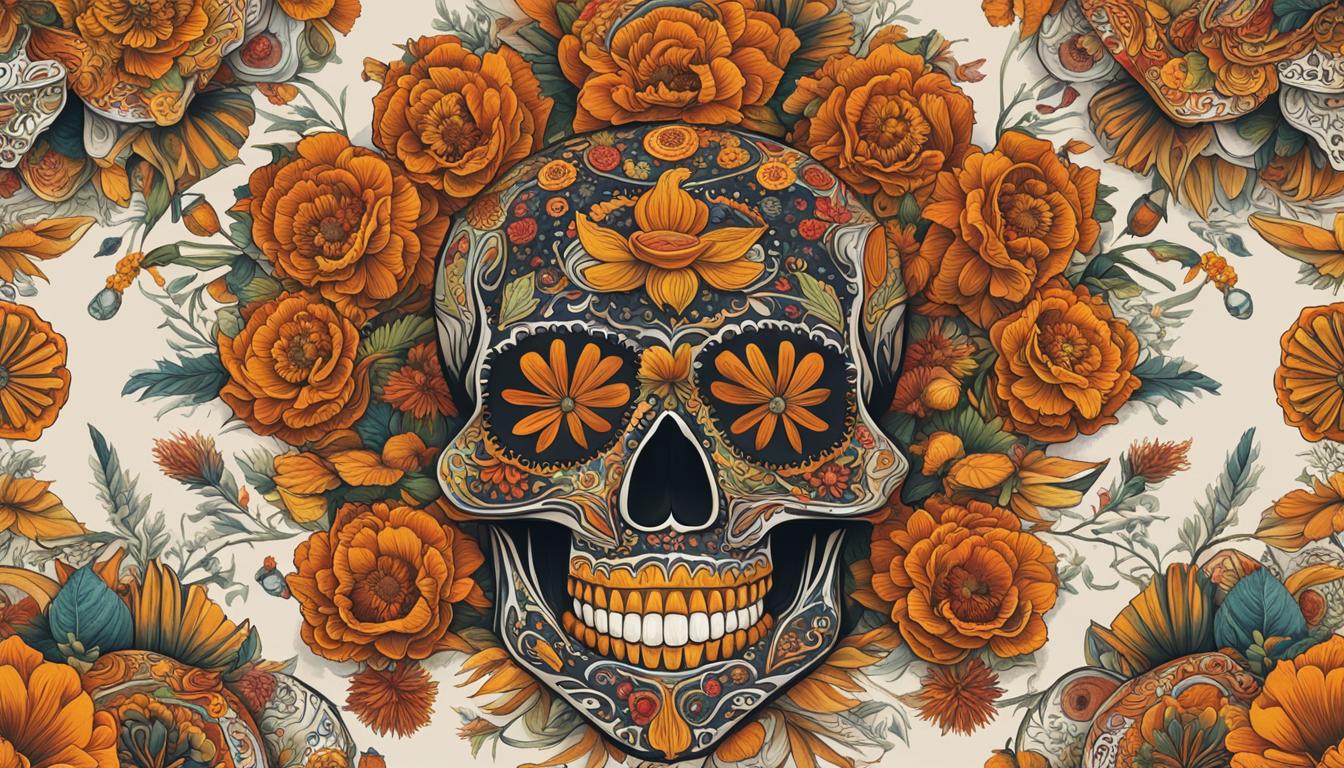
Conclusion
In conclusion, the Day of the Dead is a vibrant and meaningful celebration with deep historical and cultural significance. It originated from ancient indigenous traditions and was influenced by Spanish Catholicism, creating a unique blend of rituals and symbolism. This two-day celebration on November 1st and 2nd allows people to remember and honor their deceased loved ones in a joyful and festive atmosphere.
Throughout its history, the Day of the Dead has evolved and adapted, gaining popularity not only in Mexico but also around the world. Its rich symbolism, colorful traditions, and emphasis on embracing the cycle of life and death have captivated people from different cultures and backgrounds.
Moreover, this celebration has had a significant impact on art, media, and cultural identity. The iconic imagery of skeletons and skulls has become a prominent theme in various artistic expressions, while movies like “Coco” have brought the Day of the Dead to a global audience. It also plays a crucial role in preserving indigenous heritage and reinforcing a sense of cultural belonging.
As the Day of the Dead continues to evolve and adapt to modern times, it will undoubtedly endure for generations to come, providing future generations with a powerful connection to their roots and a meaningful way to remember and celebrate their ancestors. This vibrant celebration will continue to inspire people with its rich traditions and enduring symbolism.
FAQ
What is the historical background of Día de los Muertos?
The Day of the Dead, or Día de los Muertos, is a centuries-old celebration that originated with the indigenous Aztec rituals and was influenced by Spanish Catholicism.
What are the origins of Day of the Dead?
The Day of the Dead has its roots in the indigenous peoples of Mesoamerica, including the Aztecs and Maya, who believed that death was a natural part of the cycle of life and celebrated it with elaborate burial ceremonies and shrines.
What are the symbols and traditions of Day of the Dead?
The Day of the Dead is characterized by symbols such as altars, or ofrendas, adorned with photographs, mementos, flowers, and food. Skeletons and skulls, known as calacas and calaveras, are also prevalent in the celebrations.
What is the significance of Día de los Muertos?
Día de los Muertos provides an opportunity for people to remember and honor their deceased loved ones, keeping their memory alive and recognizing their impact on their lives. It also serves as a reminder of the cycle of life and death and the preciousness of life.
How popular is the Day of the Dead in the United States?
The Day of the Dead has gained popularity in the United States in recent years, especially among those who want to reclaim their indigenous heritage. The recognition of the holiday by UNESCO in 2008 and the release of the film “Coco” in 2017 have also contributed to its popularity.
Does the Day of the Dead exist in other cultures around the world?
Similar celebrations honoring the deceased exist in other cultures around the world, such as Bolivia, Brazil, and Spain, taking place during the same time of year. Each culture brings its unique customs and rituals to honor and remember their loved ones.
How has the Day of the Dead impacted art and media?
The iconic imagery of skeletons and skulls has been incorporated into various forms of artistic expression, such as paintings, sculptures, and literature. The release of the film “Coco” in 2017 brought the Day of the Dead to a global audience and further popularized the celebration.
How has the Day of the Dead evolved over time?
While the core traditions and symbolism remain the same, the way people celebrate may vary based on individual interpretations and regional customs. The celebration continues to be a vibrant and dynamic expression of love and remembrance.
What is the message behind Day of the Dead as a celebration of life?
The Day of the Dead is a celebration of life rather than a mournful occasion. It is a time to remember and honor loved ones, to celebrate their lives, and to embrace the natural cycle of life and death.
What is the cultural significance of the Day of the Dead?
The Day of the Dead is deeply ingrained in Mexican culture and serves as a way to connect with ancestral roots, preserve indigenous traditions, and reinforce community bonds. It promotes the idea that death is not something to be feared but something to be embraced as an integral part of life.
How does Day of the Dead relate to family traditions?
The Day of the Dead is a deeply personal and family-oriented tradition. Families come together to honor their deceased loved ones, sharing stories, memories, and favorite foods. It is a time for reflection, healing, and finding comfort in the presence and guidance of ancestral spirits.
Is Day of the Dead celebrated outside of Mexico?
Yes, the Day of the Dead has become a global phenomenon. People from different cultures and backgrounds embrace and participate in the celebration, appreciating its beauty, symbolism, and the opportunity to remember and honor their own departed loved ones.
Will the Day of the Dead continue in the future?
The Day of the Dead is a living tradition that continues to evolve and adapt with the changing times. It is likely to endure for generations to come, providing future generations with a powerful connection to their roots and a meaningful way to remember and celebrate their ancestors.
How does Day of the Dead impact identity and cultural heritage?
The Day of the Dead plays a crucial role in shaping and preserving cultural identity and heritage. It reinforces a sense of belonging, fosters pride in ancestral traditions, and highlights the rich cultural diversity of the Mexican people.



